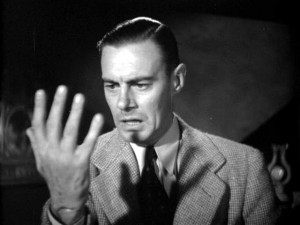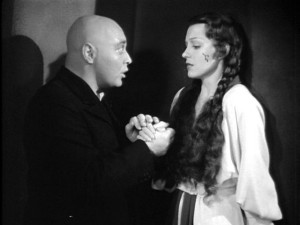
Though best known as a cinematographer (and architect of the three-camera sitcom technique), Karl Freund also directed a handful of movies. The only ones anyone remembers are The Mummy (1932) and Mad Love (1935)—and if you see things like Moonlight and Pretzels (1933) and Gift of Gab (1934), it’s not hard to see why. Of the two, The Mummy is by far the better film, but the incredibly sadistic Mad Love is probably the more personal—at least if we believe the rumors about Freund’s personal life, and the feel of the film fuels that fire. It’s an uneven film with a reputation that definitely exceeds its actual value. The story is effective enough. Yvonne Orlac (Frances Drake) is the star of a Grand Guignol theater where she’s “tortured” on stage nightly—much to the arousal of her biggest fan, surgical genius Dr. Gogol (Peter Lorre), who is heartbroken when she announces her retirement. But then her concert pianist husband, Stephen (Colin Clive), gets in a train wreck that leaves his hands mangled. The only hope is—of course—Dr. Gogol, who grafts the hands of executed knife-murderer Rollo (an oddly cast Edward Brophy) onto Stephen. That’s where the trouble really begins—but the nature of the trouble isn’t as clear-cut as it looks, even if the operation does leave Stephen with the uncanny ability to throw knives.

The overall film is entertaining enough, but it works more in bits and pieces than as whole. The scene with the character presenting himself as the executed Rollo (“They cut off my head, but that Gogol put it back”) is definitely one of the more unsettling moments in classic horror. However, as with most MGM horror films, there are some pokey stretches and an overall sense that something just isn’t quite right. Maybe it’s the impression that the studio just felt it was really “better” than this sort of thing. Still, when Mad Love is good, it’s very good indeed—and no one could possibly better suggest crazed, obsessive, sado-masochistic love better than Peter Lorre (here in his first horror role). And there’s Colin Clive—an actor who always appears to be just an inch away from hysteria—as the perfect embodiment of the tormented Stephen Orlac.

The film got a weird sort of fame in the early 1970s when Pauline Kael somewhat bizarrely concluded that Peter Lorre’s bald dome and the existence of a cockatoo in this film was “proof” that cinematographer Greg Toland was the “real” visual force behind Citizen Kane (1941), since Toland shot both, and Kane also has a bald-headed Orson Welles and shot of a cockatoo in it (not that Toland likely had anything to do with either aspect of Mad Love). Trust me, it took more than a bald head and a bird to make Kane. (Things like this have a good deal of bearing on why film historians are an easy mark for satire.)
The second film, Edgar G. Ulmer’s The Black Cat (1934), on the other hand, is an endlessly fascinating work that needs no apologies on any level. The Thursday Horror Picture Show ran this early on, so I’ll direct you to that review: http://www.mountainx.com/movies/review/black_cat_and_the_raven
The Thursday Horror Picture Show will screen Mad Love and The Black Cat on Thursday, May 31, at 8 p.m. in the Cinema Lounge of The Carolina Asheville and will be hosted by Xpress movie critics Ken Hanke and Justin Souther.




but the nature of the trouble isn’t as clear-cut as it looks, even if the operation does leave Stephen with the uncanny ability to throw knives.
This has always struck me as a little unplausible. Surely the throwing skill is as much in the arms as the hands?
An irritating lapse in logic marring an otherwise perfectly believable story.
an otherwise perfectly believable story
Welllll…